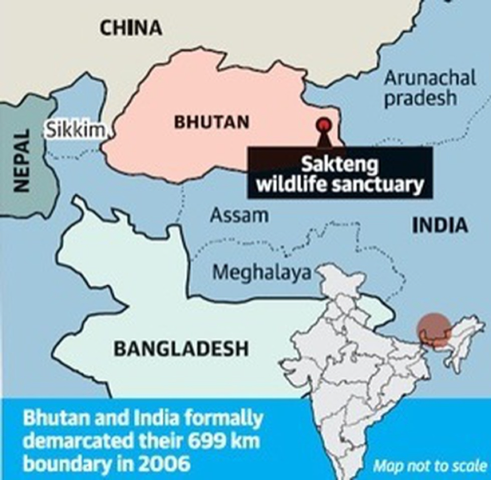UPSC Articles
INTERNATIONAL / SECURITY
Topic: General Studies 2 and 3
- India and its neighborhood- relations.
- Security challenges and their management in border areas
Another front: On India, Bhutan and China
Context: For the third time since early June 2020, China has repeated its territorial claims in the eastern sector of Bhutan’s Trashigang district.

What is China’s Territorial claim?
- According to China, the Sakteng Wildlife Sanctuary is located in the China-Bhutan disputed areas which is on the agenda of China-Bhutan boundary talk.
- China’s first claim was at a UNDP-led Global Environment Facility (GEF) conference on June 2-3, when the Chinese representative tried to stop funding for the Sakteng forest reserve in Bhutan’s eastern district of Trashigang.
- China claims that the boundary between China and Bhutan has never been delimited and that it has had disputes over the eastern, central and western sectors of Bhutan.
Why is the claim by China surprising?
- China has not objected earlier to funding provided to the sanctuary at the GEF.
- The Trashigang area, where Sakteng is based, does not share a boundary with China.
- Chinese officials have not raised the eastern boundary in 24 rounds of talks with Bhutan, that began in 1984. Thus far, talks have been only about the
- Bhutan’s north – Pasamlung and Jakarlung valleys
- Bhutan’s West: Doklam and other pasturelands that come up to the trijunction point with India.
What is Bhutan’s position?
- Bhutan totally rejected the claim made by China and was able to secure the funding from GEP
- Bhutan said that Sakteng Wildlife Sanctuary is an integral and sovereign territory of Bhutan.
- Bhutan has conveyed its position to China through its embassy in New Delhi, as Bhutan and China do not have any formal diplomatic relation
- After repeated claims by China in past two months, Bhutan has now appeared to take a sober view of China’s claims by saying that all disputes would be taken up in the next round of China-Bhutan talks.
Concerns for India
- Sakteng is situated along the border with Arunachal Pradesh, some part of which is also claimed by China.
- Even after the India-Bhutan Friendship Treaty of 2007, Indian military is virtually responsible for protecting Bhutan from the kind of external threat that the Chinese military poses.
What is the Strategy behind Chinese claims?
For Bhutan
- Pressure tactic: It is an attempt by China to hurry the scheduling of the next meeting, or to gain leverage in the boundary talks.
- Boundary talks between China & Bhutan — the last round was in 2016 — have been put off due to the Doklam stand-off in 2017, elections in 2018, and pandemic in 2020
- Reiteration of a “package solution” by China during these period as a solution for China-Bhutan boundary dispute.
- It refers to a deal offered by Chinese in 1990s whereby China was ready to give up its claims on 495 km2 in the norther region in exchange for control of 269 km2 in the western region (Doklam & Chumbi Valley)
For India
- Wedge between India & Bhutan: China’s new territorial claim is a part of the larger Chinese tactics of putting pressure on India’s smaller neighbours, to punish them for any closeness to India.
- Diversionary Tactic: India which is already dealing with Chinese aggression across the Line of Actual Control, the Sakteng claim could be a diversionary tactic
- Extend Claims on Arunachal Pradesh: By claiming Bhutan’s eastern boundary, China is attempting to double down on its claims over Arunachal Pradesh, neither of which it has lien on or control of.
- To gain Control of Doklam region located near Strategically important Siliguiri corridor of India
- The repetition of its “package” offer is worrying as it implies that Beijing is not giving up its push for the Doklam plateau, located near trijunction of China,India & Bhutan
- China has consolidated its military infrastructure in Doklam Plateau -and would like to inch towards India’s Chumbi valley, a strategically sensitive location.
Conclusion
No matter what Beijing’s designs are behind its new claims, India & Bhutan must stay the course, with the close cooperation and complete understanding they have shared for decades, in order to respond to them purposively.
Did You Know?
- India has proposed to build a Guwahati- Trashigang-Tawang link road
- The road, which has strategic significance, will reduce the distance between Guwahati and Tawang by 150 kilometre
- This will enable India to deploy troops faster to respond to any military moves by China, not only across Tawang, but also towards the eastern region of Bhutan

Connecting the dots:
- India-Bhutan Friendship Treaty of 2007
- Doklam Crisis of 2017











